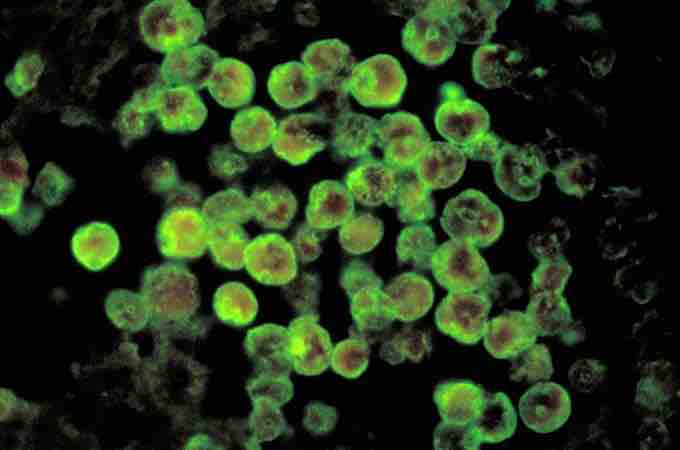Primary amoebic meningoencephalitis (PAM, or PAME) is a disease of the central nervous system caused by infection from Naegleria fowleri.
Naegleria fowleri is commonly referred to as an amoeba but is actually a unicellular parasitic protist that is ubiquitous in soils and warm, stagnant bodies of freshwater, especially during the summer months . Patients typically have a history of exposure to a natural body of water.

Naegleria fowleri
Antibody detection (green) of Naegleria fowleri, the organism responsible for Primary amoebic meningoencephalitis (PAM).
The organism specifically prefers temperatures above 32 °C, as might be found in a tropical climate or in water heated by geothermal activity. The organism is extremely sensitive to chlorine (<0.5 ppm). Exposure to the organism is extremely common due to its wide distribution in nature.
However, thus far the only route for Naegleria fowleri to enter the central nervous system is via deep insufflation of infected water as it attaches itself to the olfactory nerve, which is exposed only at the extreme vertical terminus of the paranasal sinuses.
When this occurs, it then migrates through the cribiform plate and into the olfactory bulbs of the forebrain, where it multiplies itself greatly by feeding on nerve tissue. During this stage, occurring approximately 3–7 days post-infection, the typical symptoms are parosmia, rapidly progressing to anosmia (with resultant ageusia) as the nerve cells of the olfactory bulbs are consumed and replaced with necrotic lesions.
After the organisms have multiplied and largely consumed the olfactory bulbs, the infection rapidly spreads through the mitral cell axons to the rest of the cerebrum, resulting in onset of frank encephalitic symptoms, including cephalgia (headache), nausea, and rigidity of the neck muscles, progressing to vomiting, delirium, seizures, and eventually irreversible coma. Death usually occurs within 14 days of exposure as a result of respiratory failure when the infection spreads to the brain stem, destroying the autonomic nerve cells of the medulla oblongata.
The disease is both exceptionally rare and highly lethal: there have been fewer than 200 confirmed cases in recorded medical history as of 2004, and 300 cases as of 2008, with an in-hospital case fatality rate of ~97% (3% patient survival rate). Its high mortality rate is largely blamed on the unusually non-suggestive symptomology in its early stages, compounded by the necessity of microbial culture of the cerebrospinal fluid to effect a positive diagnosis. The parasite also demonstrates a particularly rapid late-stage propagation through the nerves of the olfactory system to many parts of the brain simultaneously (including the vulnerable medulla).
Michael Beach, a recreational waterborne-illness specialist for the Centers for Disease Control and Prevention, stated in remarks to the Associated Press that the wearing of nose-clips to prevent nasal uptake of contaminated water would be an effective protection against contracting PAM, noting that, "You'd have to have water going way up in your nose to begin with".
PAM can be effectively treated with antimicrobiotics, if the patient is treated early enough.